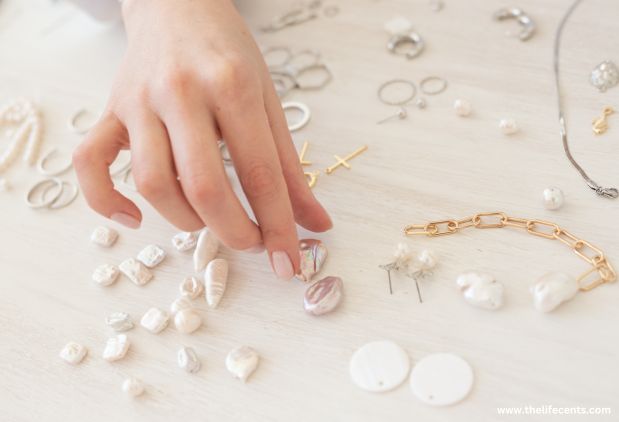The search for one-of-a-kind unique handmade jewelry pieces brings joy to people searching through highly produced accessory markets. Both self-expression and support for passionate artisans become possible through choosing unique homemade personal items.
Having the ability to recognize genuine handmade jewelry becomes essential for anyone who wants to dress to impress either at formal events or in daily outfits. This reference will assist you in recognizing genuine items that align with your personal design preferences.

Understanding Unique Handmade Jewelry
The distinctive features of Unique handmade jewelry result from both its handcrafted production technique. Home-made art pieces communicate stories and represent how artists want to be seen through their work. The following points will help you identify special handmade jewelry when searching the market:
1. Craftsmanship and Detail
The evaluation of custom handcrafted jewelry should focus on examining the skillful workmanship. Look for intricate details, such as:
- Hand-etched designs: These show the artist’s skill and dedication.
- Quality materials: Genuine gemstones, metals, and sustainable materials indicate authenticity.
- Finishing touches: Well-polished edges and secure clasps are signs of quality work.
2. Artisan Background
Researching the artisan behind the piece can provide insights into its uniqueness. Many artists share their stories and processes online, allowing you to connect with their vision. Look for:
- Artist bios: These often highlight their journey and inspiration.
- Social media presence: Follow them to see their latest creations and ideas for handmade jewelry.
3. Limited Editions
The artisan community produces custom and restricted edition pieces besides creating unique creations. To find unique handmade jewelry, customers should inquire about both limited runs and exclusive design offerings during their purchase process. The uniqueness of your choice secures a special ownership that very few people possess.
Artists tend to put their creative strength into limited edition artworks which proves highly desired by collectors. Your ownership of these distinctive items produces both unique collection value and distinctive individual ownership quality.
4. Personalization Options
Personalization of handmade jewelry items stands as one of their distinctive characteristics. Many artisans offer personalization options such as:
- Engraving names or dates
- Choosing specific colors or materials
- Creating bespoke designs based on your ideas for handmade jewelry
5. Unique Materials
Artisans use experimental materials in their handcrafted works to give them unique distinction from products of industrial manufacturing. Look for:
- Recycled elements: Sustainable practices are increasingly popular among artisans.
- Natural stones and organic materials: These can add a distinctive touch to any piece.
6. Storytelling Elements
Each piece of unique handmade jewelry item carries its narrative to tell beings. Specific events from nature personal life or cultural traditions enhance the value of any object. Learning the creative source behind artisan work will deepen your understanding of their artworks.
A necklace copied from ocean wave design will obtain its uniqueness through hand-carved shells and sea glass. Fixing jewelry meaning to emotional stories enables you to wear jewelry that holds personal value.
7. Quality Over Quantity
Before purchasing unique handmade jewelry, prioritize products for their high-quality standards over an abundance of choices. Your collection will gain significance by acquiring a few thoughtfully created products instead of multiple ordinary pieces. Buying products of high quality will result in items that last longer while delivering satisfaction to customers.
The durable materials that hand craftsmen use in their jewelry designs ensure product longevity because they exceed the quality of mass-produced jewelry which breaks or tarnishes quickly. Your wardrobe becomes more organized and sophisticated by owning less yet higher-quality clothing items.
8. Community Engagement
User interaction with local communities occurs either through workshop activities or exhibition events. Almost all commercial goods are handmade so participating in these events lets you learn how to make handmade jewelry while providing direct encounters with artists to gain deeper insight into their craft.

These events serve as perfect occasions to support local businesses alongside finding unknown places around your immediate community. Interacting with artisans creates stronger bonds with their design process while helping to maintain age-old manufacturing methods.
Conclusion
Recognizing one-of-a-kind unique handmade jewelry demands people with keen observation skills along with a deep understanding of handmade work and sincere communications with jewelry artists. By focusing on quality, storytelling, and personalization, you can find pieces that resonate with your style and values. Unique jewelry serves both fashion and self-expression purposes boosting your self-esteem because it enables you to show up confidently in your outfits.
FAQs
1. What defines unique handmade jewelry?
Unique handmade jewelry emerges from both the artisanal expertise and the visual creativity of its developer.
2. How can I tell if a piece of jewelry is truly handmade?
Examine the product’s handwork details which include inconsistencies as well as high-quality materials and design elements characteristic of the artisan’s creative process.
3. Are there specific websites or platforms for finding unique handmade jewelry?
Yes! Websites including Etsy together with ArtFire as well as local artisan markets allow people to locate distinctive handmade products made by different creators.
4. Can I request custom designs from artisans?
Most artisan jewelry makers accept custom job opportunities and appreciate ideas for handmade jewelry!
5. How do I care for my unique handmade jewelry?
Customers need to obtain care instructions from artisans to understand proper cleaning methods and storage techniques for maintaining product longevity.

